Have you got a sewing machine for Christmas...
and would like to start making your own clothes? You've come to the right place! In this post, I will share with you the basics on how to start making your own clothes, from tools to patterns, fabrics, sizes and more. Let's start!
My sewing story
I know that the thought of making your own clothes can be a bit overwhelming but trust me, the feeling that you get when wearing something absolutely unique and made by you is priceless -and don't let me start on what you feel when someone asks: "Where did you buy that dress?", and you reply: "I made it". Peak happiness! ;)
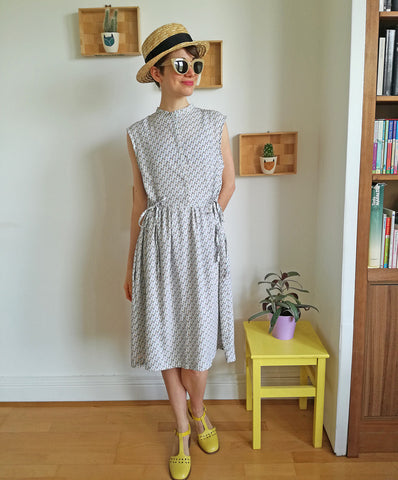
My sewing story started around 10 years ago when I attended a beginners sewing class in London. I was looking for a hobbie to help with my mental health and randomly found a place by searching on the Internet. I booked a class and the rest is history!
During those classes, I made a pouch with a zipper, a cushion cover, a tote bag and we mended a garment of our choice that we brought from home. The place felt magical to me. All the bolts of fabrics surrounding us, the sound of the machines working, the calm I felt focused on each task as my brain, finally, slowed down... I thought I had found my calling.
Of course, it doesn't need to be like this for you -I ended up changing careers, studying at the London College of Fashion and starting my humble sewing and quilt pattern company, but! it can for sure become a very rewarding part of your life. You can meet new people, be part of a community and widen your horizons culturally and personally.
And now, to the nitty-gritty ;)
What you'll need to start sewing
1. Get a sewing machine
I always recommend going for a model that is not too basic, so that you don't end up needing an update soon or so expensive, that you may regret it if in the end sewing is not for you. Something mid-range that would see you improving from a beginner to an intermediate sewist will work best.
A good idea also is to, if possible, try your machine before buying it -some shops allow people to test them. You can also read and watch online reviews to help with your decision and if you know someone with the machine that you want, go and ask them if they are happy with it. Don't be shy, the sewing community is kind and they won't mind helping you if you are polite :)
Another suggestion would be to attend a beginner sewing class in person to get a taste before commiting to buying a machine. When you get it, practice as much a possible doing basic stitches and using scraps of fabric.
Last, reading the manual that comes with the machine is also a great idea (even if boring), as it will show you many important details. You will learn how to thread the machine, which presser feet come with it, types of stitches and even how to solve possible problems.
PSST. Wait for special sales along the year to get your machine for a better price!
Below, you can find my first machine that my partner gifted me, a Janome bought at John Lewis in London. I gave it to my mum when I decided to get an upgrade. It was mechanical and felt a bit clunky after a while.

My second machine was another Janome that I really loved but that started malfunctioning badly with no simple or cheap solution possible.
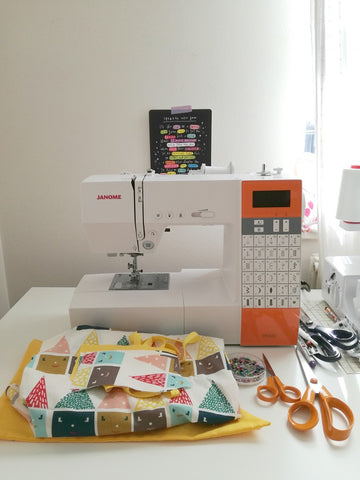
My third sewing machine and the one I still own, is a Pfaff Quilt Ambition 630 bought in 2020. You can find a review I made of the machine on my YouTube channel.

2. Create a basic tool kit
Don't buy too many things at the beginning after you get your machine. You can always invest in more specific tools and gadgets when you become more confident and when you have decided that you like it. Some of my basics are:
- Pins. Glass-head ones are easier to use.
- A small set of hand-sewing needles of different sizes, and a thimble.
- Fabric scissors, paper scissors and small trimming scissors.
- An unpicker, also known as a seam-ripper (and also known as your best friend when you are learning ;) and even later!), to break stitches when you need to redo a seam.
- Tape measure.
- Marking tool (fabric pen, a piece of chalk... Always test it on a scrap of the fabric you are going to use to make sure it doesn't leave a stain).
- Iron and ironing board.
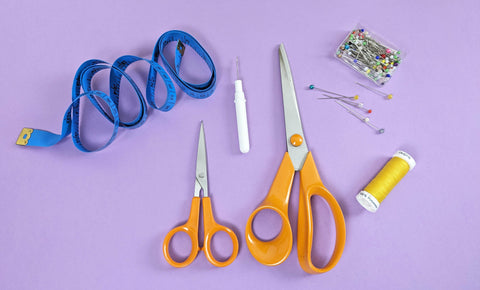
3. What to make first
If you have never used a sewing machine before or don't have much experience with sewing, I wouldn't start with a garment. A cushion cover, a pouch, a tote bag or a fabric basket are all good ideas. You can find thousands of tutorials online to make any of these.
4. Choosing a sewing pattern
After some practice and when you feel more confident, you can move onto making your first garment. My suggestion? Choose a woven dress or a top with a simple, loose A-line and not much fitting involved. Always check both the measurements chart and the finished measurements chart to decide your size. If you are in between sizes, go for the bigger one, as you can always adjust later.
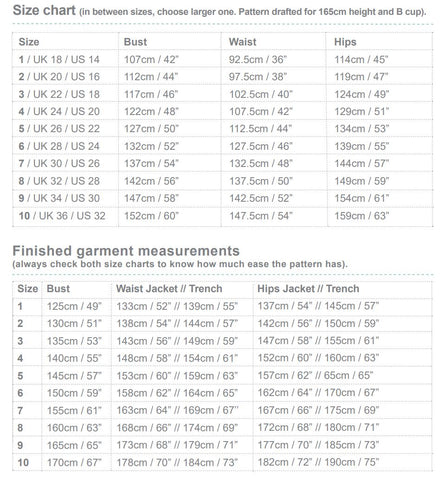
Japanese pattern books have really nice basic designs to start with. This one below was my first dress ever!
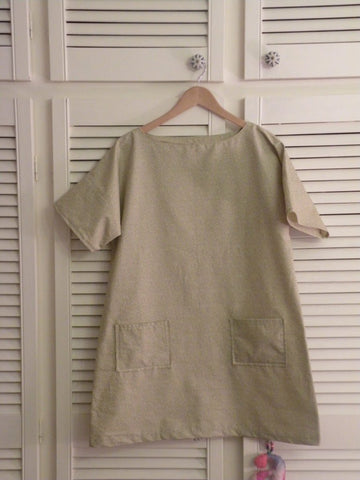
You can also get a sewing book to practice different techniques. From CocoWawa, both Plum and Marshmallow dresses (pictured below) would be a good choice.
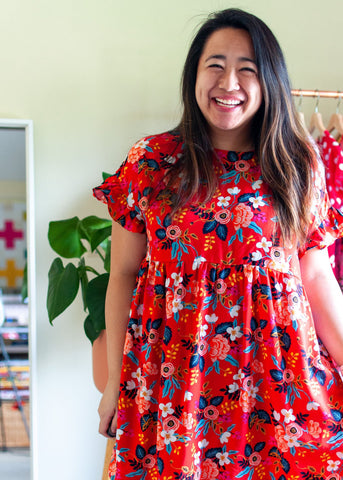
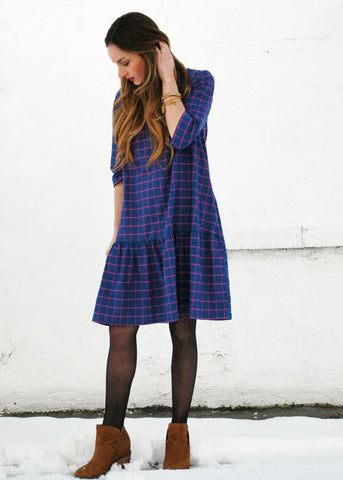
Sewing patterns are usually sold as downloadable PDFs -that you print at home or take to a copy-shop to get them printed- and / or on paper format. Not all companies print their patterns but most of them offer a digital version.
5. Finding the fabric
This is usually one of the most fun parts of the sewing process and the one that can really hit your bank account hard ;) When starting, I suggest using woven fabrics (non stretchy) like cotton or a linen and cotton blend. Jersey and knit fabrics are a bit more difficult to work with so you can leave these for a future project.
Again, don't buy the nicest, most expensive fabric you can find for your first garment. Try to buy on a budget and face the project more like an experiment, like practice. You can also make what is called a toile or muslin, which is like a test of your garment to check the size and make any necessary changes to the pattern pieces before cutting onto your final material. You can use a much cheaper fabric for this.
Check the suggested fabric materials mentioned in the pattern instructions as the creator would have made that design with specific materials in mind. Try also to buy them in person to get a feel for the different textures. Some online shops offer a swatch service and many independent ones will happily help you if you have any questions.
PSST. Don't get too carried away by all the beautiful fabrics you find. It might be tempting to buy material for future projects, but you may end up with a huge collection not really being used.
Something that I do is to try and only buy fabric for projects that I already know I want to make. First comes the pattern, then the fabric, when possible.
(I mean, I am no saint ;) Sometimes you see a fabric that you love and that's it, you have to get it. I would lie if I'd say I've never quickly found a project I REALLY NEEDED TO MAKE when seeing a gorgeous fabric!).
Below you can see the collection of leftover fabrics (all quilting cotton) from old quilts I've made. I keep using them for new quilts, tests, classes and for smaller projects. Currently, I have zero fabrics for garment making as I didn't have any project in mind for these season :)
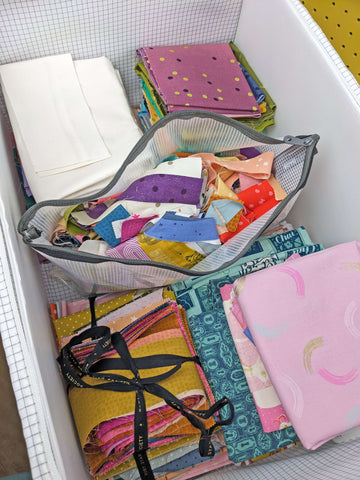
6. Let's get sewing!
The key to get better and feel more confident is to practice, practice and practice a bit more -annoying, right? hehe. You will learn a lot just by making garments and, unfortunately, by making mistakes but, remember, you will be creating something unique. You will be making clothes to fit your body and not trying to make your body fit your clothes. And you will be sewing these in the colours, prints, fabrics and materials you love most.
Don't forget that there is a huge sewing community online where you will be able to share your projects, ask questions, find inspiration from fellow makers and learn.
Online classes with me
Before I finish this post, I wanted to remind you that I offer online virtual classes. I am a sewing and quilting tutor specialized in teaching beginners how to sew and quilt :)
You can be based anywhere in the world. In the past, I have helped students with specific patterns (it doesn't need to be one of mine), solving issues with their sewing machines, making their first quilt or working on fitting issues.
You can book a class with me, which will be personalised and tailored to your needs and where you will be the only student. I use two cameras, one pointing to me and another one to the cutting table and sewing machine.
If you have any questions about my classes or about anything mentioned in this post, leave a comment or send me an email at hi@cocowawacrafts.com.
Thanks for reading and happy sewing!
Ana
xxx
